Chart Timeframes for Trading/Transacting Indices
In index trading, you'll need to decide which timeframe of trade charts aligns best with your strategy. This choice is influenced by your trading style and profit goals.
There are four main trading styles, and the one you pick decides which chart time-frame you'll use.
The 4 styles of are:
1. Scalping
2. Day trading
3. Swing trading
4. Position trading
Scalping
Scalping constitutes a trading style where a trader engages in high-volume lot sizes, aiming to secure profits from minimal shifts in the market. Scalpers execute the opening and closing of trades in rapid succession: typical trade durations range from mere seconds up to a few minutes, generally under ten minutes, or even less than five minutes for some strategies. For example, a scalper might trade volumes as large as 50 lots while targeting take profits equating to 10 to 20 points. Due to the presence of fractional points or fraction pips in stock indices, a measurement of 10 pips translates into 100 points because the final appended digit signifies a fraction.
This trade stays open just a short time with tight stops. Scalpers place stop loss at 5 to 7 pips. They pick fast markets so trades move their way quick and hit take profit. Scalpers close positions soon and use 1-minute charts for quick moves. They open 30 to 50 trades each day. This style needs traders who decide fast.
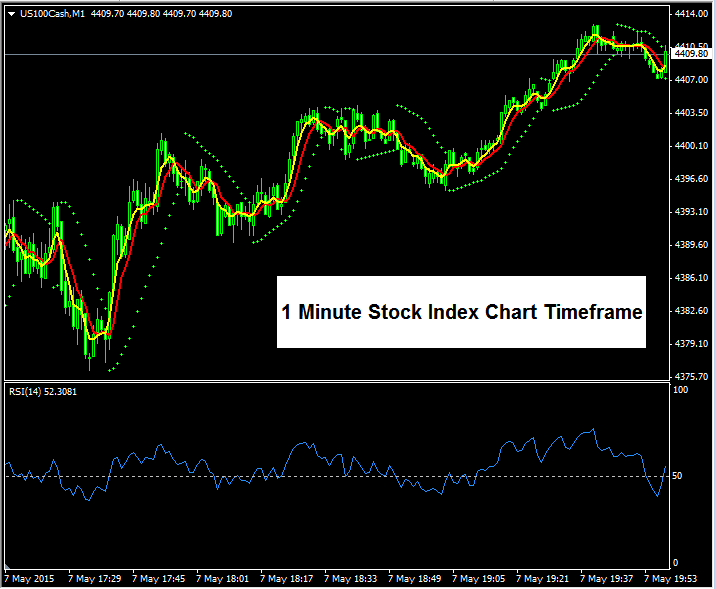
1 Minute Trade Chart Time frame for Trading
Day Trading
Day trading tops the list of popular methods. Scalpers might argue, but most prefer it. Day traders use small lot sizes. They target profits from daily trends that move 40 to 70 points on average. They trade 2 to 5 lots per position. Take profit sits at 30 to 50 points. They aim for that pip count each day. They limit trades to 1 to 3 per day. Even if targets miss, they close all positions by day's end. They wait for the next day to start fresh. That's why they call them day traders - they work only during market hours and wrap up before close.
Day Traders use intra-day charts like 15 minutes, or 1H chart depending on the time they spend on trading & also depending on which chart generates the best trading signals based on their system. If you want to become a day trader you'll have to practice with both of these chart time-frames so as to decide which chart time-frame is best for you. Some day traders are faster than other & these ones prefer the 15 minute chart timeframe, others are slower and prefer the 1H chart timeframe.
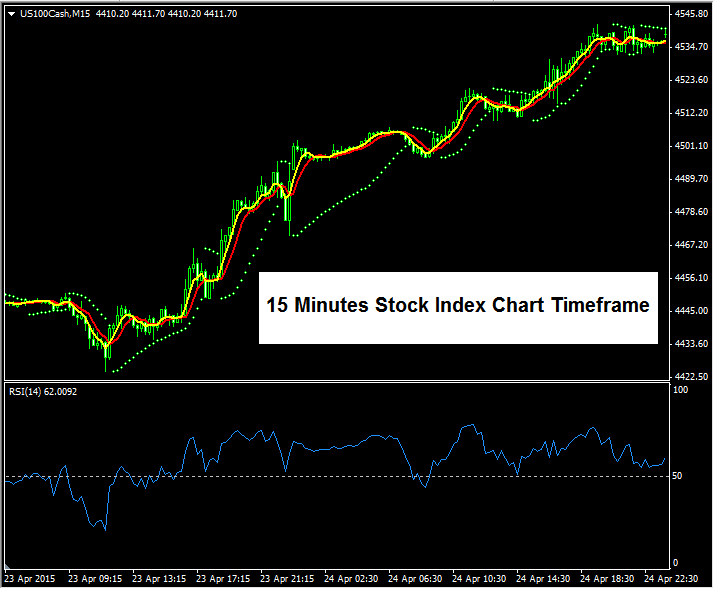
15 Minute Trade Chart Time frame - Intraday Trading
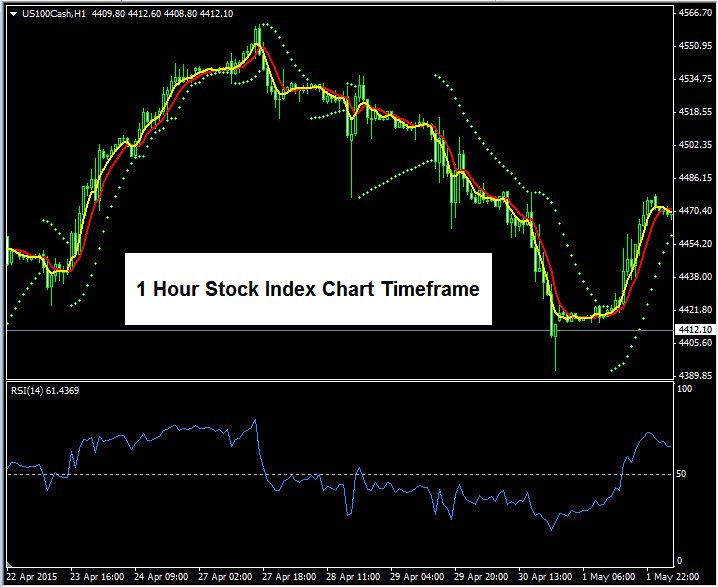
1H Trade Chart Timeframe - Intraday Trading
Swing Trading
The swing trading strategy involves initiating and maintaining trades for several days to capture additional momentum and pip gains. Swing traders leave their positions open across market closes - and as a novice, unless you possess substantial expertise, it is advisable to delegate this technique to seasoned traders. Keeping trades open overnight introduces excessive risk due to potential adverse market reversals. Swing traders typically utilize the four-hour charts to discern the intermediate market trend, entering transactions aligned with this medium-term direction. These positions are generally held for three to five days. Swing traders often employ position sizes of one, two, or three lots, keeping them active for a period of days. Conversely, day traders might only place one to three trades weekly, dedicating the majority of their time to monitoring existing open positions rather than executing new entries.
For this method the trader is ready for wide market swings, thenceforth the name swing trading.
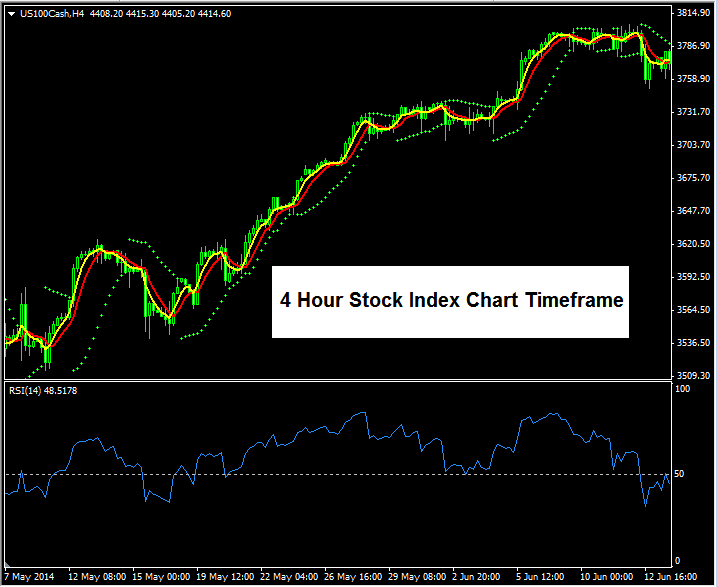
4H Trade Chart Time frame - Swing Trading
Position Trade
Traders rarely pick position trading over other styles. It acts more like investing than quick trades. This approach looks at daily and weekly charts to spot long trends. Position traders enter deals and hold them for months or years. They aim to ride the full trend's power. But big market shifts can hit hard. Sometimes prices pull back and erase gains. That's why few traders choose it. Only a handful stick with this style.
Where to Find Chart Time-frames on the Trading Platform
To pick your chart time frame, go to the Charts menu near File and View. Choose Periodicity as shown.
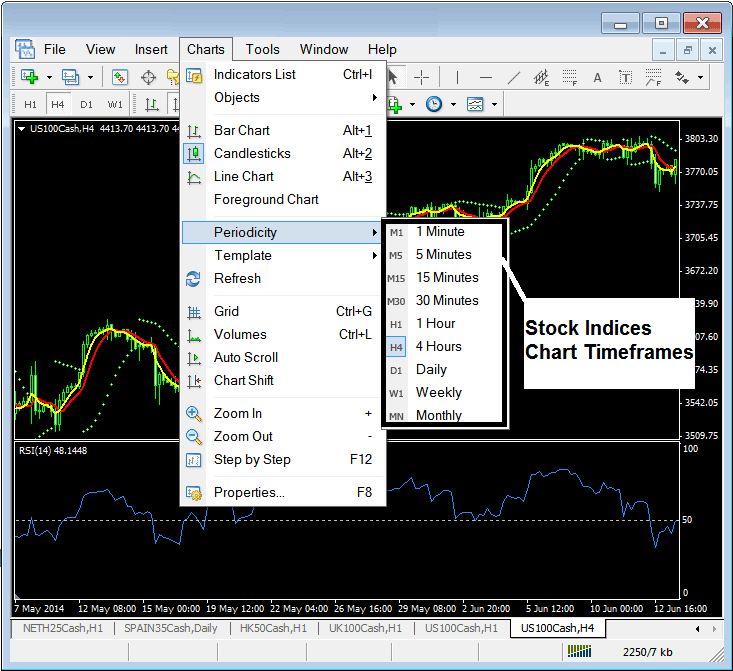
From the periodicity menu above, an indices trader can switch the chart timeframe to any they want. The active one is highlighted. For example, the chart above is 4-hour, so 4H is marked in the menu.
Learn More Tutorials and Lessons & Courses:
- Understanding the Stochastic Indicator
- Setting stop loss orders in the MT5 online platform
- The Official Opening Time for the DJI30 Index Market
- Guidance on finding the MT4 S&P 500 trade chart
- Trading Analysis Using the Linear Regression Acceleration Index Indicator
- Analyzing the Keltner Bands Index Indicator on Index Charts
- Learning About JP225 Pip Value
- How Do You Add Index Indicators on Index Charts on MT4 Software/Platform?

